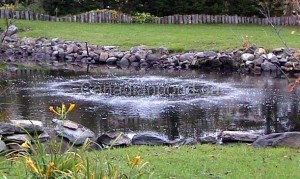DIY Aeration Systems: Here’s Where to Start
Although our complete ready-to-use systems are our most popular, our customers sometimes want to assemble their aeration system themselves.
DIY: Building Your Aeration System
The heart of your aeration system is the compressor. Canadianpond.ca offers an extensive selection of compressors suitable for many different pond dimensions. Measure your pond dimensions (length, width, depth) and describe its shape, distance to power, protected or not (i.e. shed) to us, and we will help you choose the most economical compressor and aeration system for your application. With the depth and layout of the pond, we will suggest the compressor and diffuser system based on cfm and psi unique to your pond. You may need a piston or a linear compressor, bubble tubing or a single diffuser system. We are here to help!
Before you Begin
 In order to properly gauge the size of the compressor and the diffuser system best suited to your pond, there are two important factors to consider: the true depth of the pond and the shape of the pond.
In order to properly gauge the size of the compressor and the diffuser system best suited to your pond, there are two important factors to consider: the true depth of the pond and the shape of the pond.
The pond diagram to the right shows a regular shape and a single deep area, so the recommended aeration system for this pond would be the appropriate sized piston compressor, a length of self-sinking Torpedo Tubing and a Robust Aire diffuser. If you prefer to have your compressor further from the pond, then simply run a line of regular tubing from the compressor to the water and then connect the more expensive self-sinking tubing to the diffuser. The compressor may be placed up to 1 km away from the diffuser.
Choosing the Right Sized Compressor
In order to choose the right compressor, the accurate depth of your pond or lake must be measured. Guessing or approximating may result in an over or undersized compressor being used which may affect the quality of the aeration and the life-expectancy of your compressor. If your pond has varying depths then try to find the deepest point and use that as your guide. Poor results may be encountered if you do not begin with an accurate measurement of your pond depth. This will determine the PSI (pounds per sq. inch) which in return will determine the compressor force required.
Diffusion Systems: Bubble Tubing or Stationary Diffusers
 You have a choice between diffusing air with linear Bubble Tubing or a diffuser station. Bubble tubing is used in all applications: deep, shallow, or when diffusion is required around a dock or other structure. It is easy to install, covers a large area, requires little maintenance and works well with most compressors. For steep sloped basins, air stations are best. Diffusion discs are not recommended for shallow applications because the micro-bubbles arrive at the surface too quickly.
You have a choice between diffusing air with linear Bubble Tubing or a diffuser station. Bubble tubing is used in all applications: deep, shallow, or when diffusion is required around a dock or other structure. It is easy to install, covers a large area, requires little maintenance and works well with most compressors. For steep sloped basins, air stations are best. Diffusion discs are not recommended for shallow applications because the micro-bubbles arrive at the surface too quickly.
Once the depth is known, you must consider the shape of your pond. A circular-shaped pond with a single deep area and an equally proportional interior grade may require only one diffuser at the deepest point. An irregular shaped pond with many variations in depth and bank slope may require the installation of one or more diffusers. Ponds with flat bottoms, islands or structures benefit most from linear Bubble Tubing. While the addition of any aeration is better than none, we have found that optimum benefits are attained when a pond is correctly fitted with a system conforming to accurately measured dimensions and the placement of the most appropriate diffuser system. Often we suggest bubble tubing and a diffuser station to fit a pond’s needs.